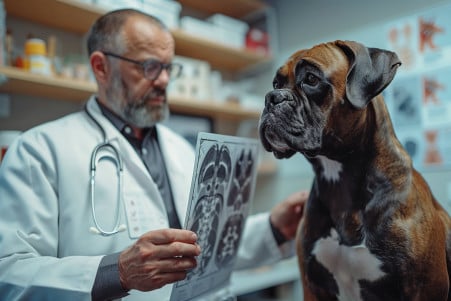How Many Bones Do Dogs Have? Exploring Canine Skeletal Variations
7 February 2024 • Updated 7 February 2024

Beyond their fur, dogs have a pretty interesting skeletal system that’s worth taking a closer look at. The average dog has between 319 and 321 bones in their body, but this can change based on the breed and the length of their tail. Dogs have more bones than humans, and the number of bones in their body is determined by their size and skeletal makeup.
In the sections below, we’ll take a deep dive into veterinary science and comparative anatomy to learn more about the dog skeletal system. We’ll also look at research that shows how the number of bones in a dog’s body can change based on breed-specific traits, from the small Chihuahua to the large Great Dane.
By the end of this article, you’ll have a good idea of what determines the number of bones in a dog’s body and how this information can be used to help dogs live their best lives.
How many bones do dogs have?
The Canine Skeletal System
The skeletal system in dogs has many important roles, including providing support, defining the shape of the body, and protecting internal organs. According to Safari Veterinary Care Centers, the skeletal system also gives dogs the leverage they need to move and acts as a mineral reserve to help with metabolic functions.
This complex system can be divided into two main parts: the axial skeleton, which includes the skull, spine, ribs, and sternum, and the appendicular skeleton, which includes the bones of the limbs and pelvis.
During the growth process from puppyhood to adulthood, a dog’s bones undergo ossification, which is the process of turning cartilage into bone. This process allows for the rapid growth that occurs during puppyhood and is important for a dog’s ability to move. For example, the strength and flexibility of the skeletal system allow dogs to run and jump.
Dogs are prone to a variety of bone-related health problems, including fractures and osteoarthritis, which can require ongoing care and attention from their owners. A strong skeletal system is important for a dog’s ability to move, protect their internal organs, and maintain their overall health. Knowing these basics sets the stage for understanding how the number of bones in a dog’s body can vary based on genetic and environmental factors.
The Genetics Behind Dog Bone Number Variation
The number of bones in a dog’s body can vary greatly, especially because of breed-specific traits. One of the factors that contributes to this variation is the tail, as different breeds have different numbers of tail vertebrae. For example, a Greyhound may have a tail with more vertebrae than a Bulldog, which typically has a shorter tail.
Genetic factors are a major driver of skeletal morphology between breeds. A paper in PubMed by Danika L. Bannasch identifies genetic variants that impact skeletal morphology within and across breeds, which helps explain the diversity of bone sizes and shapes that exist in dogs. This genetic variation also means that the number of bones can vary between breeds because of differences in skeletal traits.
A case-control study by Matthew J. Smalley, published in Canine Medicine and Genetics, shows that there are breed-specific incidence rates of bone-related health conditions like osteosarcoma. This study demonstrates that certain breeds are more likely to develop specific bone diseases based on their bone structure and body mass.
This knowledge of the genetic basis and its relationship to bone health is important for the overall health of dogs. And as we think about the developmental stages of these bones from birth to adulthood, the genetic influence becomes even more clear, and it’s this influence that makes up part of the fascinating complexity of our dogs’ physiology.
Key Phases of Canine Skeletal Development
The process of canine skeletal development is characterized by a series of complex phases that begin at birth and continue through the juvenile period to adulthood. According to a study posted in PubMed, ossification centers are first seen in the forelimbs of puppies at three weeks of age, and complete skeletal growth is finished by 40 weeks of age.
This timeline of skeletal development phases is also influenced by breed, with larger breeds taking longer to reach maturity than smaller breeds.
Nutrition plays a critical role in this developmental process. An article posted in PubMed notes that growth hormones and certain nutrients, including calcium, phosphorus, and vitamin D, are required for the normal growth of canine bones. It’s important to maintain the right balance of these nutritional components, especially during the rapid growth periods of puppyhood, to prevent skeletal abnormalities.
A study posted on ResearchGate points out that environmental factors, including exercise and the age at which neutering is performed, can impact the musculoskeletal development of puppies. Neutering at a young age, for example, can result in delayed growth plate closure and longer limb bones.
By knowing these things, we can better understand the many factors that influence the skeletal development of our dogs. This knowledge of skeletal development not only helps us understand the current health of dogs but also gives us insight into the evolutionary process that has led to the wide range of skeletal shapes and sizes seen in dog breeds today.
Domestication and Genetic Changes in Dog Bone Structure
The skeletal system of dogs has changed significantly through evolution, and domestication has played a major role in the wide variety of skeletal morphologies found in different dog breeds today. A paper in PMC by Travis D. Lorentzen shows that these morphological differences are due to a combination of genetic factors, and it identifies quantitative trait loci that control skeletal traits.
These genetic factors have played a critical role in the domestication of dogs from their wild ancestors and have led to the many different skeletal structures found in different breeds.
In addition, a review in The Anatomical Record of the domestication of dogs shows that the domestication process has led to major morphological and genetic changes. These changes have not only affected behavior and somatic traits but have also changed the very structure of our dogs.
The example of brachycephaly, which is discussed in a paper by M S Fischer in Integrative Organismal Biology, is one of the most extreme changes in skeletal structure that has resulted from human selection. This skull shape, which is found in breeds like the Bulldog, shows how far-reaching the changes that selective breeding can make are, including their impact on breed-specific skeletal structures and health.
Knowing the evolutionary background of dogs helps us understand their anatomy and can help us make sure that we’re taking the best care of the skeletal health of the many different breeds of dogs.
How to Help Your Dog Build Strong Bones
Maintaining strong, healthy bones is essential for your dog’s overall health and wellness. One of the most important factors in bone health is a well-balanced diet that includes important vitamins and minerals. Four Leaf Rover suggests feeding your dog a diet that includes plenty of calcium for strong bones, vitamin D to help with calcium absorption, and vitamin C to help with collagen production—all of which are important for maintaining a healthy skeletal system.
In addition to a healthy diet, regular exercise is important for maintaining healthy bones. According to Cuteness, dogs of all ages, sizes, and breeds need exercise that’s tailored to their energy levels and physical needs to help prevent bone-related problems.
Watch for signs of bone-related issues, such as a lack of interest in play, limping, or signs of pain when you touch your dog. Catching these issues early can make a big difference in the success of treatment. Regular vet check-ups can help catch problems before they become serious, and your vet can offer breed-specific advice on how to maintain healthy bones.
With the right diet and care, it’s possible to manage the skeletal issues that are common in certain breeds, so your dog can enjoy a happy, healthy life. By staying on top of your dog’s bone health, you can set the stage for a long, happy relationship with your furry friend.
In Conclusion: The Mystery of the Canine Bone Count
After this deep dive into the intricacies of the dog skeletal system, it is clear that the number of bones in a dog can range from 319 to 321. This number is not fixed and changes based on the length of the tail in certain breeds and other physiological differences.
The importance of these physiological differences cannot be overstated, as genetic differences like the curly tail of a Pug or the long back of a Dachshund determine the number and arrangement of bones in each breed.
The history of domestication and selective breeding in dogs has led to an incredible amount of diversity in the skeletal system. Understanding this diversity is important because it is a key part of a dog’s overall health and well-being. The complex relationship between genetics, nutrition, and the environment in the development of bones shows that a one-size-fits-all approach to dog care is not the best option.
In conclusion, research is important in helping us learn more about the anatomy of dogs. With every new piece of information we learn about the biology of dogs, we get closer to ensuring the health and well-being of our furry friends.


